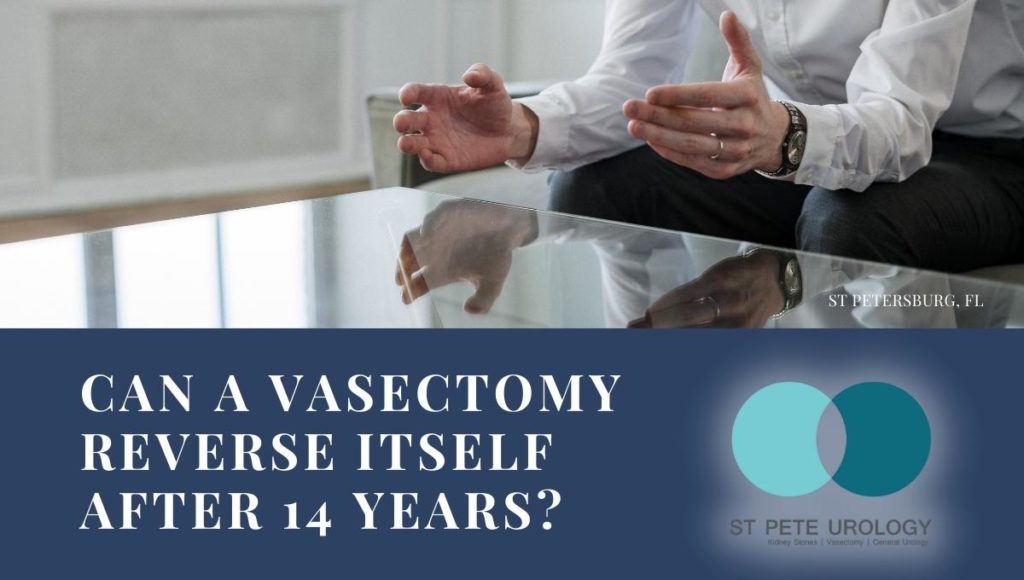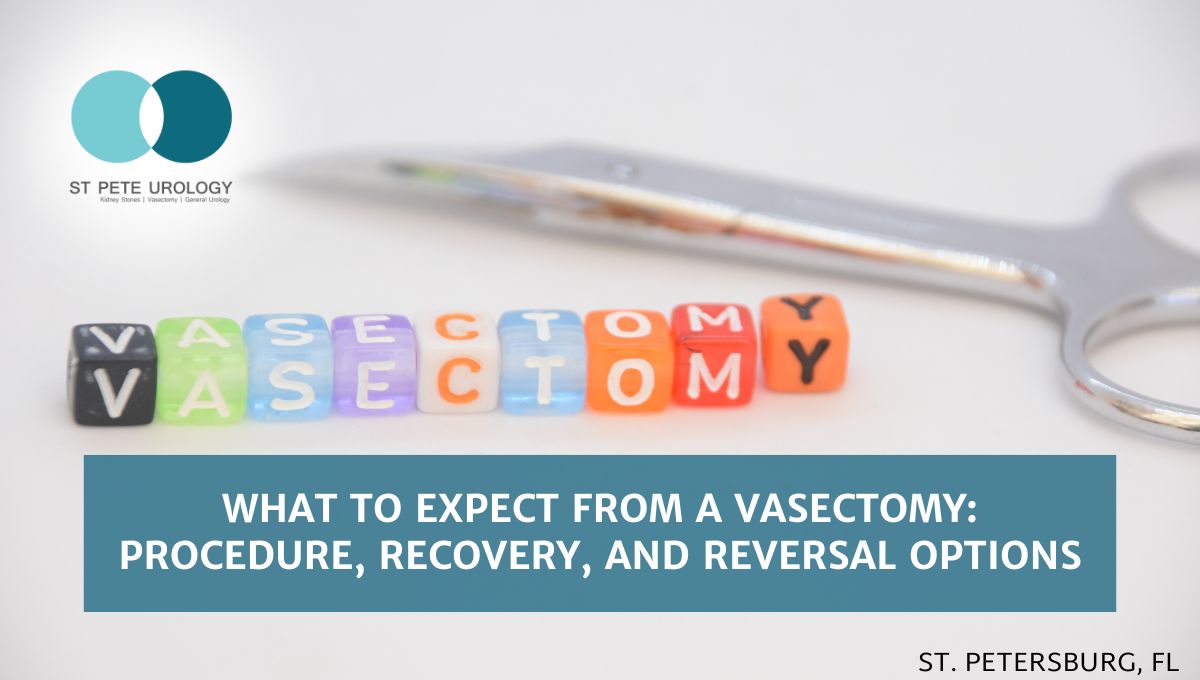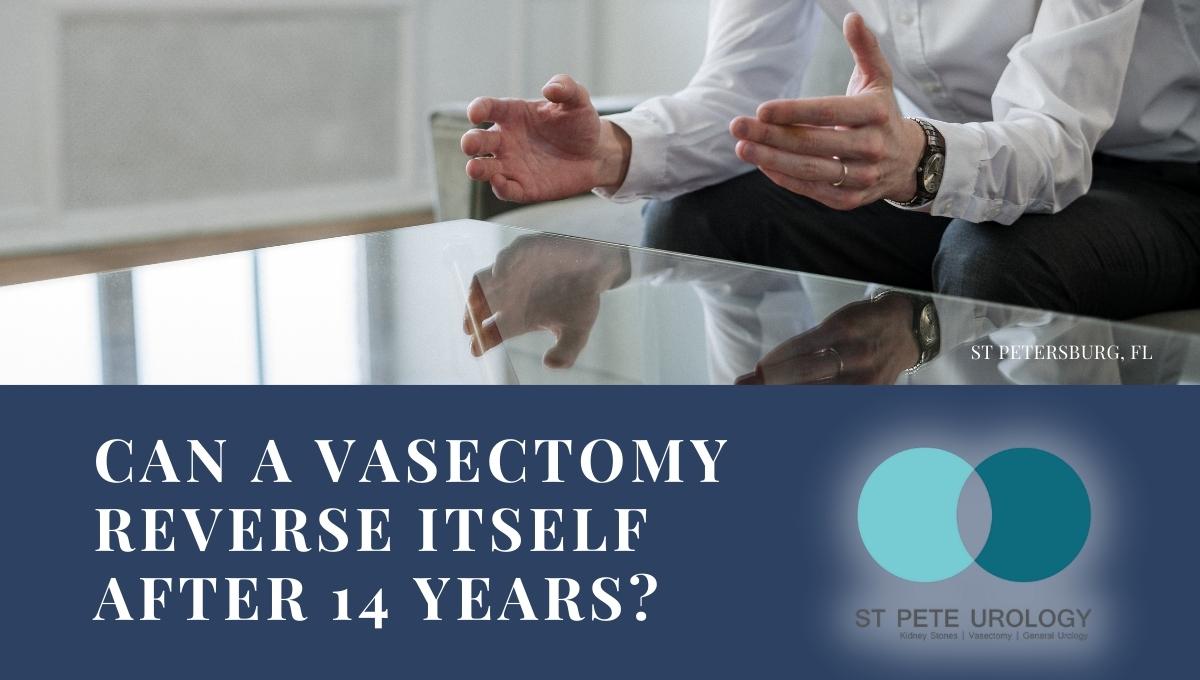Considering a vasectomy procedure? Learn what to expect during the procedure, recovery timeline, success rates, and fertility restoration options including vasectomy reversal from St Pete Urology.
Continue readingHow Can a Prior Vasectomy Procedure Be Reversed with Vasectomy Reversal?
What You Need to Know About Vasectomy Reversal
The Pros and Cons of Vasectomy
What are the Success Rates of a Vasectomy Reversal?
Can a vasectomy reverse itself after 14 years?
A vasectomy is one of the safest and most effective birth control methods. But like other medical procedures, it isn’t foolproof.

There is a possibility that a vasectomy can fail to prevent pregnancy in extremely rare cases with roughly a 1-percent chance of failure.
Though vasectomy failures can be due to various reasons, several cases are due to a reversal of the procedure over time.
How can a vasectomy reverse itself?
In rare instances, a vasectomy can reverse itself and is known to occur in about 0.025 percent of cases, equivalent to 1 reversal in 4,000 vasectomies. Such a reversal involves reconnection of the vas deferens after successful surgery and an effective post-vasectomy plan.
Remember that during a vasectomy, the vas deferens—the two tubes that carry sperm from the testicles to the urethra—are cut and sealed off to block sperm from reaching semen. The channel in the vas deferens is broken at the point where it is cut to eliminate the passageway of the sperm to combine with the semen.
However, in some cases, the vas deferens grow back several years after the procedure. The growth may continue until a connection is recreated, allowing the free flow of sperm to the urethra.
An extremely rare and successful reconnection can occur after 10 to 14 years or more and is usually almost impossible to notice.
Most men only realize that their vas deferens have reconnected after their sexual partners get pregnant.
What can make a vasectomy reverse itself?
After a vasectomy, sperm may leak from the vasectomy site or a rupture and directly into the epididymis. Since sperm have immune system stimulating properties (antigenic qualities), it recognizes sperm as foreign and attacks them.
The sperm leakage triggers an inflammatory reaction that causes the body to develop pockets to trap the sperm in scar tissues and inflamed cells.
With time, spheres of cells called sperm granulomas form and produce nodules in the vas deferens that may grow and result in the reconnection of the vas deferens.
The risk of a reversal increases with the presence of sperm tissue at the vasectomy site.
Another reversal mechanism is scar tissue.
With cells present after a vasectomy forming tiny channels that allow sperm to squirm their way through the tiny tears in the scar tissue, small drainage channels appear in the tissue on the ends of the severed vas deferens. Over time, these channels may reconnect to the divided vas deferens, providing a pathway for sperm to the seminal vesicles. The risk of a reversal via scar tissue increases with open-ended vasectomy, where only one end of the vas deferens is closed.
However, you shouldn’t be overly concerned if you consider a vasectomy or have already undergone the procedure.
The chances of a reversal are pretty rare—almost negligible—and extremely unlikely in most cases.
At St. Pete Urology, we are proud of our excellent record of successful vasectomies. Our skilled and experienced urologists understand the factors that may lead to vasectomy failure, including non-severance of the vas deferens, non-observance of a period of sperm-free ejaculate, reconnection of the vas deferens, and duplication of the vas deferens. So we tailor and conduct every vasectomy under strictest adherence to best practices.
Call St. Pete Urology today for more information on vasectomy and vasectomy reversal.
Long Term Risks of Vasectomy
 Vasectomy is a one-time male contraception procedure that provides 99.9 percent efficacy in preventing pregnancies. It offers permanent contraception and, compared to the female procedure of tubal ligation, vasectomy is:
Vasectomy is a one-time male contraception procedure that provides 99.9 percent efficacy in preventing pregnancies. It offers permanent contraception and, compared to the female procedure of tubal ligation, vasectomy is:
- Simpler.
- More effective.
- Safer, with fewer complications to patients.
- Much less expensive.
- Conveniently performed on an outpatient basis.
Following a vasectomy, you will find sex with your partner more spontaneous and enjoyable. After all, you will no longer have to worry about a potential pregnancy or need to interrupt pleasure to apply contraception.
So what are the long-term benefits and risks of a vasectomy?
Vasectomy is typically performed on younger men in their thirties and forties. These men still have many years of their lives during which long-term health effects might appear.
Luckily, medical studies have examined the long-term health impact of vasectomy and the evidence suggests there are no significant risks. In fact, men who have undergone vasectomy have basically the same risk of developing heart disease, cancer, or other health problems as those who have not.
Let us now consider the specific issues.
1. Vasectomy and testosterone levels
Vasectomy does not affect the secretion and release of testosterone—the male hormone responsible for facial hair, sex drive, deep voice and other masculine traits. Hormonal tests in those who have had a vasectomy show that there is no significant change in both free and total testosterone. Hormone levels in the body remain within normal range. There is also no significant difference in testicular or epididymal size after a vasectomy.
2. Vasectomy and sexual function
Can a vasectomy affect your sexuality negatively? Studies indicate there is no such effect. Apart from changing your fertility, a vasectomy will not influence your sexual and reproductive physiology. The nerves that are critical for erectile function and ejaculation remain intact and you will still achieve normal erections, climax and produce the same amount of ejaculate—only that your semen will not have sperm.
The procedure will not diminish your libido, which is related to various hormones in the body that are not altered by the surgery. Even your sperm production remains normal except that they are reabsorbed in the body. So the only change you are likely to have is ability to enjoy yourself without the worry of pregnancy.
3. Pain, discomfort and abscesses
The cause of post-vasectomy pain syndrome is unclear, but on rare occasions when it occurs, it can be a challenging urological problem. An estimated 1-2 percent of men experience chronic scrotal pain after a vasectomy that ranges from a dull, aching sensation to a sharp, biting pain. There is no single treatment for the pain, but your urology will tailor a solution for you should it occur, and it will rarely require further surgery to reduce or correct.
Abscesses are quite rare after a vasectomy, but they may occur. In typical cases, they result from post-operation infection at the surgical site. Fortunately, most respond to treatment with antibiotics and eventually resolve. However, when left untreated, the abscesses can fill with fluid and may need to be drained. So if you suspect you have an abscess after a vasectomy, you should see your urologist immediately to stop the condition from getting worse.
4. Epididymitis
In 1-3 percent of men who undergo vasectomy, inflammation of the epididymis may occur—a condition called epididymitis. The epididymis is a duct found behind the testicles that allows flow of sperm to the vas deferens. It is highly coiled and very narrow; since sperm still flows through the epididymis to the vas deferens after a vasectomy, the duct may get inflamed when the sperm get backed up as the vas deferens is already severed.
Inflammation of the gland is rare, but is often characterized by tenderness, pain and swelling. Some urologists recommend anti-inflammatory drugs to help with epididymitis, though the swelling should be gone within a week or so after surgery. If it gets worse after the first week, speak with your urologist about it.
5. Sperm granulomas
Cutting the vas deferens during a vasectomy ensures sperm is stopped from reaching scrotal tissues. In some cases, however, the sperm may leak through the cut vas deferens into scrotal tissues. When this occurs, the sperm may form a hard, occasionally painful lump or mass, the size of a pea, called granuloma in the scrotal tissue.
Once formed, a lump can cause small bumps or cysts, which range in size from 1 millimeter to 1 centimeter. Lumps may also produce multiple lesions that tend not to produce symptoms, though some men may experience pain at the granuloma areas. Studies estimate that 15-40 percent of men undergoing vasectomy have sperm granulomas.
While sperm granulomas are not usually dangerous and often gets absorbed by the body, some cause pain and swelling in the genital region. Actually, the entire area may become sensitive to temperature and pressure changes. Most granulomas respond to anti-inflammatory drugs and the sensitivity and swelling subsides within a week after treatment. But in some extremely rare cases, reverse vasectomy may be necessary if the leakage does not stop and the swelling becomes increasingly worse.
6. Vasovenous fistula
This is another rare risk of vasectomy. It occurs when several blood vessels adhere to the vas deferens injured when vasectomy is done. It can cause pooling of blood vessels leading to development of a fistula, or abnormal association between the vas deferens and close by blood vessels. The symptoms of vasovenous fistula may include blood in ejaculate or urine. Although the risk is quite rare, you need to seek immediate medical attention should these symptoms occur.
7. Immune based illnesses
Some men may have immune reactions to the sperm that gets absorbed in their bodies after a vasectomy. The effect is the possibility of immune reactions that may lead to heart disease and other immune-based illnesses. However, many extensive studies have concluded that a vasectomy does not lead to immune-based illnesses or heart disease later in life. In fact, studies show that the risk of immune-based illnesses is so insignificant that it should not concern either the urologist or the patient.
8. Vasectomy and cancer
One serious concern has been the possibility of a vasectomy increasing the risk of having prostate or testicular cancer. A study published in the Journal of the American Medical Association in 1993 suggested that 20 years or more after a vasectomy, men who have undergone the procedure are twice as likely to develop prostate cancer compared to men of the same age group who have not undergone the procedure.
However, reviews of the study by the medical community have since demonstrated that the study did not include enough participants and the findings are therefore not statistically significant. In fact, compared to other studies that have used PSA tests to establish the possible risk of prostate cancer, the general consensus is that vasectomy comes with no increased risk of the cancer.
The risk of prostate cancer among men who have and those who have not undergone the procedure is the same when PSA tests are combined with digital rectal exam, ultrasound or prostate biopsy. Therefore, as a rule, men should undergo prostate cancer screening whether or not they have had a vasectomy. Likewise, there have been no reports of increased risk of testicular cancer after a vasectomy.
At St Pete Urology, we have offered vasectomy services for decades and we are proud of the results. The procedure has minimal long-term risks compared to other surgical procedures and provides men the freedom to enjoy sex without having to worry about a possible pregnancy. And the risk of prostate cancer, testicular cancer, heart disease, immune-based illnesses and other conditions are too insignificant to stop you from having a vasectomy.
We are ready to answer all your vasectomy related questions and concerns during your consultation. For more information, schedule a consultation or visit the St Pete Urology website.
Can a vasectomy fail?
A vasectomy is a form of male contraception that is administered through a minor surgical procedure. During a vasectomy, the patient’s vas deferens are cut and the ends are tied up or seared so they are blocked. The vas deferens is made up of two narrow tubes that transport sperm to the ejaculatory duct during ejaculation. A vasectomy inhibits the transportation of the sperm to the duct, so only seminal fluid is discharged when a man ejaculates. The absence of sperm removes the possibility of conception. A vasectomy is considered to be the most efficient form of birth control. However, there are instances, though very rare, in which pregnancy occurs even after the man has had a vasectomy.
Reasons why a vasectomy may fail
1. Recanalization
This is a medical term for when the cut vas deferens reconnect and revert to something like what they were before the vasectomy. This process happens naturally when tissue from the cut ends gradually grows until the two ends reach one another and reconnect.
Tiny channels also can form in the healing scar tissue of the snipped vas deferens and provide a passageway for sperm from one end of the vas deferens to the other.
2. Surgical error
In very rare cases, surgeons have been known to make an error during the procedure. This might mean either that the vasectomy was not done at all or that it was done in a manner that might cause it to fail.
Such errors could be:
a. Cutting one vas deferens and leaving the other;
b. The surgeon cuts completely different tubes that are not the vas deferens; and
c. In the very rare cases where the patient has duplicated vas deferens, that is to say two vas deferens on each side rather than one on each side as is the normal case, and the urologist cuts only one of the two .
d. Having intercourse too soon
Men who have had vasectomies are always advised to avoid having sex too soon, and if they do, to use another form of contraception. This is because semen does not become clear of sperm immediately after the vasectomy. The standard practice is to wait for three months after the procedure. After the three months, a urologist should conduct a semen analysis and advise accordingly.
Vasectomies are largely successful. Any man considering it has absolutely no reason to fear that it will fail because they rarely do. However, after undergoing the procedure, the patient must take care to observe all guidelines given by the urologist. A little anxiety before the procedure might be expected but the advice of a trained urologist, such as those available at St Pete Urology should dispel the worry. The team of specialists at St. Pete Urology can help with questions, consultation, surgery and follow up steps for a vasectomy. For more information, visit the St Pete Urology website.
5 Facts Men Need to Know About Vasectomy Reversal
Facts about Vasectomy Reversal
A vasectomy reversal aims at rejoining the cut ends of the epididymis or unblocking them if they had been sealed. Important facts include:
1. It is a precise but outpatient procedure. A vasectomy takes about two hours. The patient can go home the same day. The fact that it is an outpatient procedure, however, should not take away from the fact that vasectomy reversal is a very precise operation that makes use of micro surgical techniques. The sutures made are extremely fine.
2. High success rate. Vasectomy reversal procedures are reported to have a success rate of over 90 percent. Even so, patients should appreciate that the rate of conception will be influenced by factors beyond themselves, such as the fertility of their partner. As such, conception may not happen immediately.
3. The procedure. A vasectomy reversal involves making two incisions on the side of the scrotum through which the vas deferens can be accessed. The surgeon then cuts open the tied or sealed ends and sutures them together.
4. Age of the vasectomy may affect success rate. Reports indicate that vasectomies done not more than ten years ago have the highest success rates. The success rate starts to decline when the vasectomy was performed more than fifteen years ago.
5. Short recovery period. Due to its relatively minor nature, a vasectomy reversal heals quickly and requires little after care. Patients, however, are advised to wait at least six weeks before they return to having sex.
The success of a vasectomy reversal requires almost pinpoint accuracy. A patient, therefore, should place a great deal of weight on the experience and training of the urological specialist or surgeon who does the procedure. St. Pete Urology has a strong track record of experienced specialists who can work with the individual in determining what is the best plan for him and answer questions or concerns. For more information, visit the St Pete Urology website.
Vasectomy Reversal – Does it REALLY work?
Success rate of vasectomy reversal
The success rate of reconnecting the tubes severed during vasectomy is quite high, about 90 percent. After a successful reconnection of each tube, sperm is again able to pass from the testicles through the tubes and reach semen, and a man may again be able to get his partner pregnant. But the success of a vasectomy depends on a number of factors, such as the state of the tubes during the reversal and how many years have elapsed since the vasectomy was done.
If you undergo a vasectomy reversal within seven years of the vasectomy, the reversal is a simple procedure of putting the vas deferens back together. But if the tubes are too short to reconnect, if there is scarring or it’s been more than seven years since you had the vasectomy, the reversal process may be more complex. However, even with the more complex procedure, the success rate is still around 50-60 percent with no much difference in pregnancy rates — the average being 50-60 percent likelihood of pregnancy, which drops to 44 percent if time since a vasectomy is greater than 15 years.
If the time since vasectomy is less than 15 years, the reversal provides a pregnancy rate that’s higher than in vitro fertilization (IVF) and sperm aspiration with intra-cytoplasmic sperm injection (ICSI). And even after intervals greater than 15 years since a vasectomy, the reversal still gives outcomes equal or greater than IVF with ICSI.
Vasectomy reversal techniques
Vasectomy reversal is usually performed in two ways. The first technique is vasovasostomy (VV), which is basically the piecing back together of the two sides of the tubes (vas deferens) — that is vas deferens to vas deferens. The other technique is vasoepididymostomy (VE), which involves reconnecting the vas deferens to epididymis, the duct that transports sperm to the vas deferens. Generally vasovasostomy (VV) is done if sperm is present in the vas fluid. If sperm isn’t present in the fluid, vasoepididymostomy (VE) is the go-to procedure. In some cases, a combination of both techniques may be necessary, with a vasoepididymostomy done on one side and a vasovasostomy on the other.
A vasoepididymostomy is slightly more complicated and therefore chosen only when a vasovasostomy is impossible or can’t work. You won’t know the technique that the surgeon will use until the operation begins and that usually depends on whether sperm is present in the fluid found in the vas deferens at the time of surgery. Both are outpatient procedures that take less than 3 hours. A man has a successful vasectomy reversal if sperm evaluations performed several months later indicate he has the normal sperm count necessary for conception.
How should you prepare for a vasectomy reversal?
A vasectomy reversal is a complex and expensive procedure that’s often not covered by insurance. So you should find out what you’ll need and all the costs well ahead of time. The procedure is generally more successful when performed by surgeons who are trained and experienced in microsurgical techniques and who have done the procedure several times. So when choosing a doctor for the procedure, find out how many reversals the surgeon has performed, the techniques used, how often pregnancy has occurred after surgery, and the risks and complications involved.
Similarly, you’ll need to buy tight-fitting undergarments (like an athletic supporter) that you will wear after the procedure to hold bandages in place and support your scrotum. You also will need to stop taking medications that increase the risk of bleeding, including pain relievers (like ibuprofen or aspirin) and blood-thinning drugs. You should make arrangements for your travel to and from the hospital and for the length of time you will need to recover after surgery.
What should you know before a vasectomy reversal?
Vasectomy reversal is performed as an outpatient procedure that doesn’t require an overnight stay in a hospital. Before the procedure, the surgeon will take your medical history and conduct a physical examination to make sure you’re not having any health problems that may lead to complications after or during surgery. If your physical exam shows abnormal results or you’ve got sexual function issues, the doctor may consider running some blood tests. Likewise, a review of your surgical history is done to assess whether you had any previous surgeries other than the vasectomy or prior injuries that can hinder the vasectomy reversal. The doctor also will confirm whether you can produce healthy sperm. While evidence of fathering a child before is usually sufficient proof of the health of your sperm, additional testing may be necessary if there is uncertainty.
What happens during a vasectomy reversal?
Once you’re in the operating room, anesthesia is applied to minimize discomfort during the procedure. That may either be general anesthesia to keep you unconscious throughout the procedure or a local, spinal or epidural anesthesia to minimize pain but without putting you to sleep. The surgeon then makes a small incision on the underside of your scrotum to expose the tubes (vas deferens) and free them from surrounding tissues. Cutting open the vas deferens, the surgeon examines the fluid inside the tubes to establish whether sperm is present. If it’s found that sperm is present, the doctor simply reconnects the ends of the tubes to enable sperm passage. If the fluid inside the vas deferens is pasty, thick or contains partial or no sperm, that’s usually an indication that there’s a blockage of sperm flow and that vasovasostomy may not work. In that case, vasoepididymostomy is the more appropriate procedure.
What happens after the procedure?
After the procedure, the doctor applies bandages to cover the incisions. Make sure to ask your doctor when it will be OK to take the bandages off. The stitches applied should dissolve in 7-10 days. You will be required to wear tight-fitting undergarments (like athletic supporter) and apply ice to minimize swelling. The area may feel sore for many days, but the pain shouldn’t be severe and should improve within a few days to one week.
Once back at home, make sure to take it easy and avoid any activities that may move the testicles excessively or pull on the scrotum or testicles, such as heavy lifting, biking, jogging or sporting activities. For the next several weeks, wear an athletic supporter at all times, removing it only when showering. Avoid activities such as swimming and bathing for the first two days following surgery because they can make the surgery site wet. If your job requires much driving, walking or physical exertion, seek your doctor’s advice on when it’s safe to return to work. But for a desk job, you can return to work within a few days after surgery — only making sure that nothing harms the surgery site. Do not ejaculate or engage in sexual intercourse until your doctor gives you a go ahead — that is often 2-3 weeks after surgery.
What results should you expect?
To assess the success of a vasectomy reversal, the doctor will examine your semen 6-8 weeks after surgery. If the procedure is successful, sperm will be present in the semen. The appearance of sperm in semen should happen within a few months, but may take a year or more in some cases. So the doctor may have to conduct periodic semen analysis to evaluate the success of the procedure, unless your partner gets pregnant soon after the reversal. The prospect of achieving pregnancy usually depends on a number of factors, including the age of your female partner and the duration of time that has elapsed since the vasectomy.
Can the reversal fail to work?
If a blockage develops in the tubes after surgery or there is an underlying issue with your testicles that wasn’t recognized during surgery, a vasectomy reversal can fail to work and you may need a second-attempt reversal procedure. Doctors often opt to collect and freeze some sperm during a vasectomy reversal, which can then be used if the procedure doesn’t work. But if sperm isn’t frozen during the procedure or you completely lack sperm in your ejaculate, sperm can still be retrieved directly from your epididymis or testicle to help you have children via assisted reproductive techniques, like in vitro fertilization.
At St Pete Urology, we have a huge pool of urologists trained in andrology and experienced in microsurgical techniques. We conduct the procedure under very high-level magnification using incredibly small sutures. We perform several vasectomy reversals every year and boast significantly high success rates. So if you are looking for specially trained and skilled doctors to reverse a vasectomy in a way that will maximize your chances of having children, come and see one of our urologists. For more information on vasectomy and vasectomy reversal procedures, visit the “St Pete Urology” site.




 A vasectomy reversal is a surgical procedure that reverses a vasectomy. During a vasectomy, the doctor cuts, blocks, or seals the tubes called vas deferens, thus preventing sperm from reaching semen. During the procedure, a skilled doctor reconstructs the tubes to restore the man’s fertility. Men who have had a vasectomy, but now want to become fathers can benefit from a vasectomy reversal.
A vasectomy reversal is a surgical procedure that reverses a vasectomy. During a vasectomy, the doctor cuts, blocks, or seals the tubes called vas deferens, thus preventing sperm from reaching semen. During the procedure, a skilled doctor reconstructs the tubes to restore the man’s fertility. Men who have had a vasectomy, but now want to become fathers can benefit from a vasectomy reversal. 
 Penis enhancement surgery is a procedure to correct structural and functional problems of the penis. It may be recommended after an injury, defect, or loss of function. But usually, it is a corrective measure for a micropenis or a buried penis. Both of which cause functional issues with urinating, sexual intercourse, or hygiene.
Penis enhancement surgery is a procedure to correct structural and functional problems of the penis. It may be recommended after an injury, defect, or loss of function. But usually, it is a corrective measure for a micropenis or a buried penis. Both of which cause functional issues with urinating, sexual intercourse, or hygiene.
 A
A 

